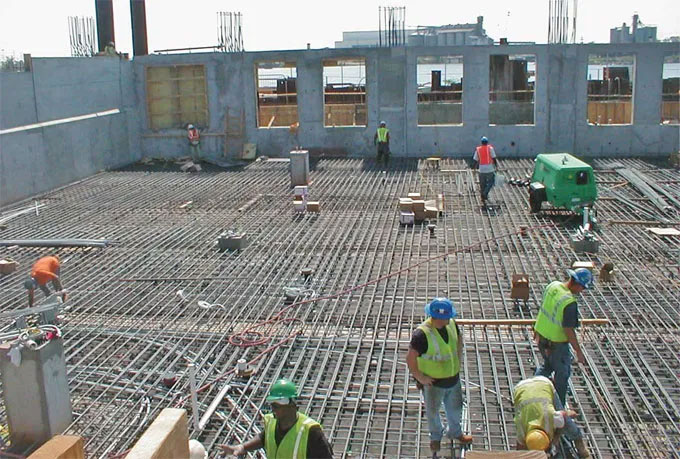
Reinforcing Concrete Slab to Prevent Cracking
Most of the slabs are unreinforced to prevent cracking. Generally, crack in concrete slabs occur due to concrete curving and exaggerated temperatures, lot of loads and subbase settlement. The upper or lower part of the slab thickness, steel reinforcement prevents the random cracks in concrete slabs. We can call this type of reinforcement as shrinkage and temperature reinforcement.
Types of Reinforcement
There are two type of reinforcement. One is structural reinforcement and the other one is shrinkage temperature.
Structural Reinforcement
This type of reinforcement is situated under the bottom part of slab thickness. It is used to rise the load capacity of slabs. Structural slabs have two-layer reinforcement, the upper and bottom layer on ground to prevent the wideness of crack and increase load capability. This type of reinforcement is very much costly. So, it is not widely used as much as nonstructural slabs.
Steel Reinforcing Bar
Steel reinforcing bars do not prevent crack. It latent in concrete slabs until the concrete slabs is getting crack. After getting crack this type of reinforcement active automatically and prevent it for further more.
If this concrete slabs places with high quality subbase and forms of low curving concrete and also joints of concrete install space of 15 feet or less than that then there is no need for steel reinforcing bar.
Few cracking may be possible in concrete bar. If there is any crack occur in slabs then it remains tight because it has limited joint spacing and low concrete shrinkage.
If slabs are structured in problematic subbase, joint space is more than 15 feet and there is no uniform support then reinforcement is very much necessary. If the width of cracking is more than .035 inches then capability of load transfer decrease and many vertical movement can happen. After happening this edge of crack is exposed. Due to spalling size of cracking become wider on surface and slab erosion increases very significantly.
If corrugation joints are not installed properly then shrinkage and temperature reinforcement is very much needed. This type of design reinforces continuously and allows very closed space joints.
Different Option to Control Cracking
There are two option available to prevent and control cracking in concrete slabs on ground.
1. Installation of corrugation joints to control the location of Cracking
Joint spacing and concrete shrinkage can control the crack and width of corrugation joints. If space of joints and quality of concrete shrinkage in concrete slabs increase then the width of joint also increase. If the size of joint width is more than 35 mils then the capability of transfer loads is also reduced.
Due to this reason many designers and engineers use load transfer devices like steel dowels, plates and continuous reinforcement so that the capability of load transfer does not reduce and to prevent the vertical movement across joints.
2. Installation of Reinforcement to control width of Cracking
Here designers allow the slabs to clack anywhere but control the width of cracking by steel reinforcement bars. In this option, corrugation joints cannot be installed. In results cracks are tightly hold together. Anyway, different option controlling crack should be always discussed with owner.
Cutting Reinforcement at Corrugation Joints
Designers and engineers should be cautious while using both type of crack control options in same concrete lab. Contraction joints become stiff and may not crack if very much of reinforcement pass through the corrugation joints.
If contraction joints do not active then there is a huge possibility of random cracking in concrete slabs. To achieve the proper activation of contraction joints designers or engineers should limit the amount of passing reinforcement through corrugation joints.
Some designers aware of cutting all the reinforcement at joints while others are aware to cut every bar. if designers cut the reinforcement then the remaining reinforcement help to spread the load transfer and not prevent the activation of corrugation joints.
Reinforcing Location
Steel reinforcement should be placed in the upper portion of slab thickness because temperature cracks happened at this surface. Generally, width of cracks is more than the depth of crack. Designers should place the reinforcement in very low area so that saw cutting do not cut the reinforcement. The position of reinforcement should be specified by marking the concrete cover for the reinforcement.
Designers should not place a single layer of reinforcement in the mid depth of concrete slab. In this position of slabs designers should be aware of increasing load capacity and control crack.
Placement Sufferance
Tolerance of vertical placement of reinforcement is ? ? inch from the marked location. The tolerance of concrete cover must be 3/8 inch for 12 inches slab thickness.
In this article we discussed about reinforcement of concrete slabs, types, use, tolerance and location of reinforcement, how to prevent crack in concrete slabs very easily. If viewers find this article informative and useful please give feedback below this article and let us know about your opinion.


